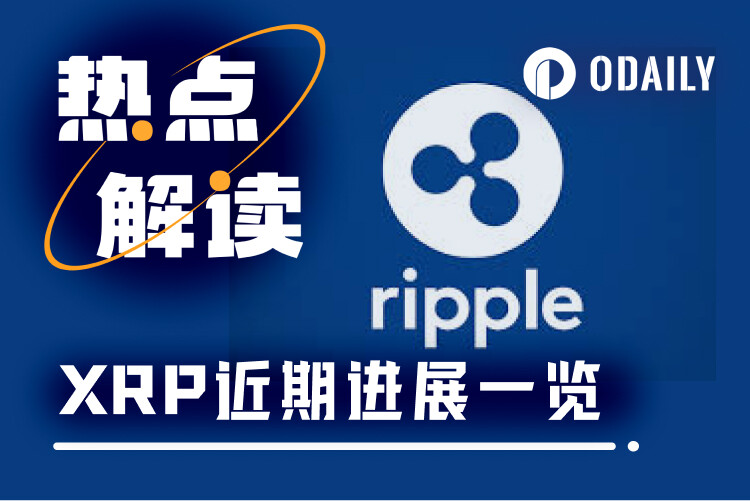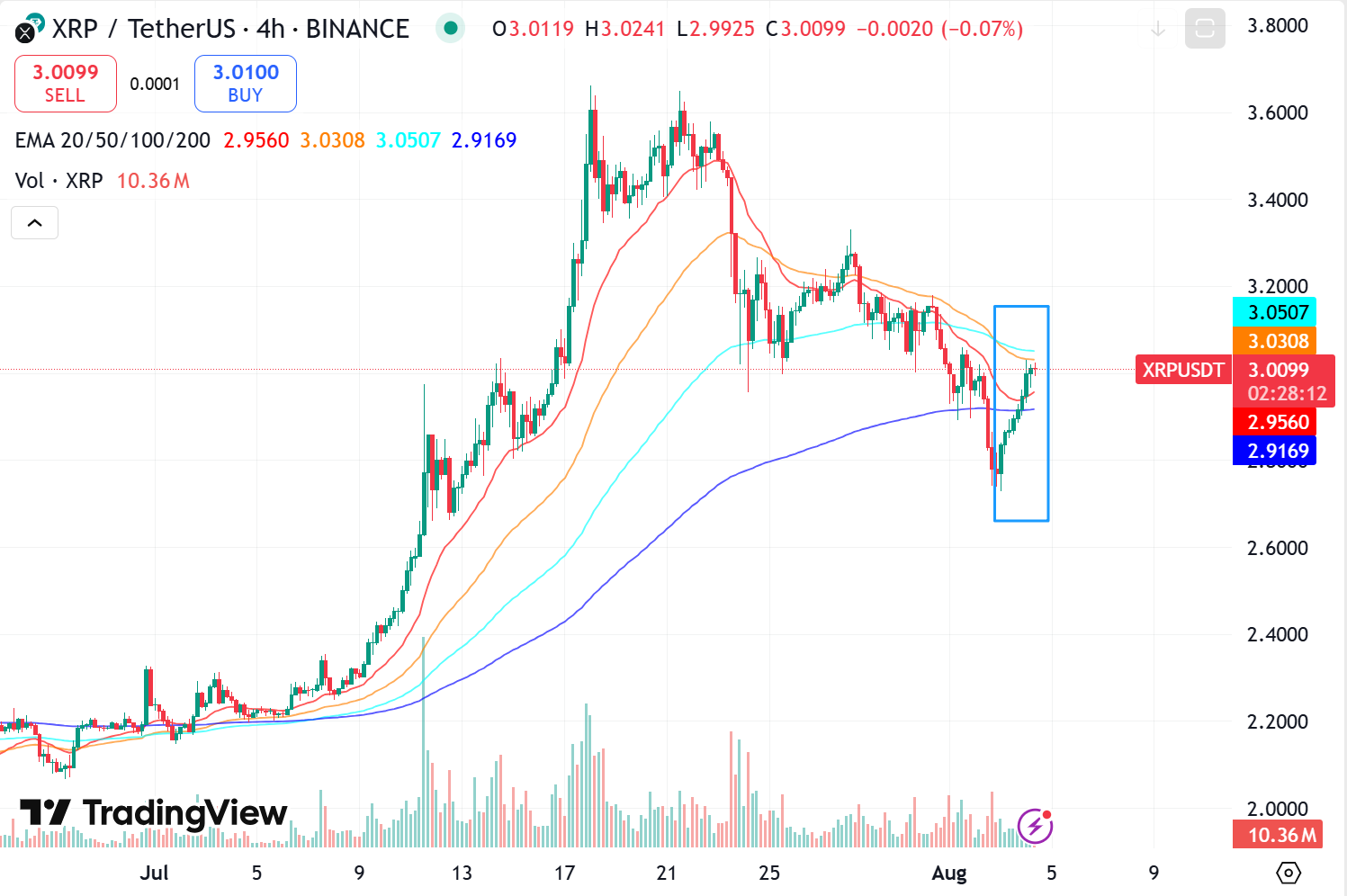Original | Odaily Planet Daily (@OdailyChina)

A week ago, Ripple (XRP) market capitalization surpassed $203.9 billion, ranking 91st among global assets, surpassing Pepsi, Uber, and BlackRock, with the gap to McDonald's narrowing to 5%. Notably, since Trump's re-election in 2024, XRP has seen a cumulative increase of over 585%, with a staggering 71.6% rise in July alone. Although its market cap recently fell back to $178 billion due to a market correction, XRP still showed strength in today's rebound.
Observing the trend over the past year, it is evident that in this new cycle led by institutions, XRP has demonstrated significant resilience—there is always capital stepping in to support it after each sharp decline. This phenomenon of "active market support" may stem from substantial changes in Ripple's fundamentals. Odaily Planet Daily will delve into its recent core changes in the following sections.

Regulatory Breakthrough: Six-Year Legal Shackles Finally Lifted
For Ripple, 2025 marks a turning point in completely bidding farewell to the "legal tug-of-war." Since 2019, the long-standing lawsuit with the U.S. Securities and Exchange Commission (SEC) has been a heavy burden on XRP's development path. It wasn't until 2023 that Judge Torres's ruling provided some breathing room: trading XRP on the open market does not constitute a sale of securities, although institutional sales still touch the red line of securities law.
By 2025, Ripple proactively withdrew its cross-appeal against the SEC, choosing to pay a $125 million fine to conclude the matter in a "settlement." The six-year compliance dispute officially came to an end, not only relieving Ripple of its burden but also opening doors for XRP's future.
Nate Geraci, president of ETF Store, stated that the end of the lawsuit cleared the obstacles for a spot XRP ETF, potentially attracting financial giants like BlackRock to enter the market. Bloomberg ETF analyst James Seyffart is even more optimistic, predicting a 95% probability of approval for a spot XRP ETF in the second half of 2025, ranking alongside Solana and Litecoin as the most likely "sub-mainstream" assets to be approved. Meanwhile, the new SEC chairman Paul Atkins issued clear guidelines indicating that the regulatory environment is shifting from "passive obstruction" to "structural acceptance."
With compliance concerns about XRP dissipating, investors are beginning to envision a larger stage for it in traditional financial markets.
Expansion of Financial Products: Mainstream Market Position Certified
The market enthusiasm for XRP is also reflected in the continuous expansion of financial products.
Coinbase Derivatives announced that it will launch nano XRP perpetual contracts on August 18, providing a legal derivatives channel for the U.S. market; on the NYSE, the ProShares Ultra XRP ETF (ticker: UXRP) has been approved for listing, offering a daily double return leveraged product. Although it is not a spot ETF, it has been seen as one of the signals of XRP's entry into the mainstream financial framework.
At the same time, Bitwise has converted all 10 of its crypto index funds into ETFs, with XRP ranking in the top five; Truth Social's "Crypto Blue Chip ETF" has also allocated 2% of its asset weight to XRP, clearly establishing its position in the "crypto blue chip" sequence.
The launch of these financial products reflects recognition of XRP's high market value, high liquidity, and low transfer costs. More importantly, as compliance thresholds lower, exchanges and institutions are accelerating the "revaluation" of XRP's potential as a financial asset.
Corporate Reserve Wave Rising: The Second Growth Narrative Emerges
If regulatory breakthroughs have paved the way for XRP, then institutional enthusiasm has given it wings. By 2025, an increasing number of companies will incorporate XRP into their financial reserves or payment systems, becoming one of the core driving forces behind XRP's rise in 2025.
Mobility service provider Webus International Limited signed a preferred stock and credit line agreement worth up to $100 million with Ripple Strategy Holdings to establish an XRP reserve pool; Thumzup Media Corporation authorized holding up to $250 million in crypto assets, explicitly including XRP; vertical farming technology company Nature’s Miracle Holding announced a $20 million XRP financial plan for operational fund management. Meanwhile, Amber International completed a $25.5 million private placement, with funds earmarked for building a $100 million crypto reserve portfolio centered on XRP, with investors including established crypto VC Pantera Capital.
From cross-border payments to corporate settlements, the actual use cases for XRP are rapidly evolving into "corporate financial tools." This emerging "reserve narrative" is moving away from the previously narrow understanding of "litigation and price," reshaping market perceptions.
On-Chain Transparency: Trust Rebuilding in Progress
Despite the impressive market performance, concerns about on-chain transparency within the XRP community cannot be ignored. KOL Andrei Jikh pointed out that while Ripple claims to have partnered with over 300 banks since 2013, there is a lack of sufficient on-chain data to support this.
In response, Ripple's Chief Technology Officer David Schwartz stated that most institutions adopt XRP based on off-chain solutions, and the XRPL itself was not designed as a high-frequency on-chain interaction platform; its value lies in supporting efficient cross-border payment channels. While this explanation addresses the phenomenon of "on-chain silence," it also exposes a core contradiction faced by Ripple—how to seek a balance between off-chain institutional use and community expectations for on-chain transparency.
On the other hand, after XRP's price fell back from its historical high of $3.66, on July 18, co-founder Chris Larsen transferred $26 million worth of XRP to Coinbase, sparking market speculation. Fortunately, this did not trigger significant selling pressure, possibly due to personal asset management needs.
Additionally, Ripple CEO Brad Garlinghouse clarified the matter regarding Linqto holding 4.7 million shares of Ripple, emphasizing the essential difference between Ripple shares and XRP. He stated that Linqto, as an independent company, acquired shares from existing shareholders, and Ripple has no control over its business actions. This clarification dispelled community misunderstandings about equity transactions and added to Ripple's transparency.
Overall, Ripple is steadily rebuilding transparent trust through public responses, institutional clarifications, and governance disclosures. This will also be another "infrastructure building" that it must complete to enter the "institutional subscription phase."
Conclusion
From the resolution of the SEC lawsuit to the increased probability of ETF approvals, and the expansion of corporate reserves and financial products, Ripple is gradually completing its transition from a "regulatory fringe asset" to a "mainstream financial target."
In the short term, if a spot ETF is successfully launched in the second half of 2025, it will become a key node for triggering the next wave of capital influx; in the long term, Ripple still needs to continue efforts to enhance on-chain transparency of XRPL and meet community expectations and institutional standards. From cross-border payments to corporate reserves, and to global financial products, Ripple's vast potential is gradually unfolding.
免责声明:本文章仅代表作者个人观点,不代表本平台的立场和观点。本文章仅供信息分享,不构成对任何人的任何投资建议。用户与作者之间的任何争议,与本平台无关。如网页中刊载的文章或图片涉及侵权,请提供相关的权利证明和身份证明发送邮件到support@aicoin.com,本平台相关工作人员将会进行核查。



